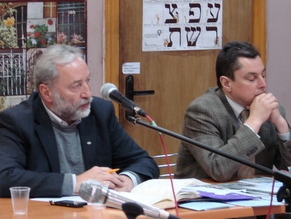|
Euroasian Jewish News

During the discussion
|
Concept of Jewish Museum Discussed in Lviv
30.03.2011 Chairman of the Euro-Asian Jewish Congress (EAJC) General Council Josef Zisels moderated a discussion of the concept of a Museum of Galitsian Jewish History and Culture, which took place in the Lviv "Hesed-Arieh." It is well-known that despite an abundance of Jewish heritage accumulated in Ukraine, the process of placing it in a museum has barely been begun. The Chernivtsy Museum of the History and Culture of Bukovinian Jews, created with EAJC help, is an exceptional case. Jewish museums in Ukraine also include the Migdal – Jewish Museum of Odessa, and the Ukrainian Jewish Community History and Holocaust History Museum that is planned to open in Dniepropetrovsk.
At the same time, the differences between Jewish groups that formed in different conditions in different regions of today's Ukraine present a special interest. Thus, the museum in Chernivtsi is dedicated to reflect the particulars of the history and culture of Bukovina Jewry. Over the centuries, in the region to which Lviv was central, a special sub-ethnicity of Galitsian Jews was also being formed; however, it was almost entirely destroyed by World War II. According to the opinion of the EAJC General Council Chairman, the future Museum of the History and Culture of Galitsian Jews needs to reflect and harmonically intertwine three aspects: the history of Galitsia, the individual life of Jews, and the community life of Jews – the activity of the many religious, charity, and community organizations, and so on.
Among the participants of the discussion were the leaders of the Jewish community, historians, professional museum workers, and representatives of the city authorities.
The central topic for discussion was the choice of a possible building for the Museum of History and Culture of Galitsian Jews. Most of the speakers deemed most suitable the building on Sholom-Aleichem street, building 12, where the Jewish museum used to be. First of all, this would indicate a certain historic succession, and second, it would be easier to attract sponsors for the reconstruction of this historic Lviv building. And financing is currently one of the main problems for the museum concept organization committee. According to the representative of the city authorities, the chances for financial support from the city are minimal, especially considering that the building is not municipal property.
Yet it would be wrong to reduce all problems to financial ones. It is very important to judge the number of museum objects and their value. The director of the Union of Councils for Jews in the Former Soviet Union (UCSJ) Meilah Sheihet called for helping the local museum workers understand what Jewish artifacts are in their possession, and then forming the exposition. The unanimous opinion of the gathering was that the exposition should highlist the Austro-Hungarian period of history of Galitsian Jews, as it is most rich in artifacts. According to Ivano-Frankovsk rabbi Moshe-Leib Kolesnik, there are hardly any regional Jewish artifacts from Middle Ages.
Maksim Sukhanov
|
|
